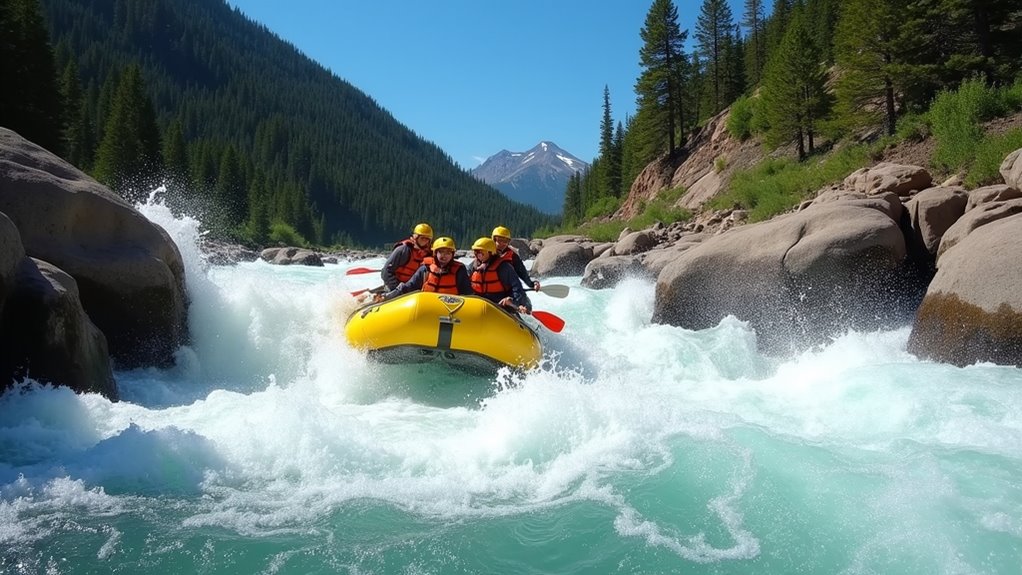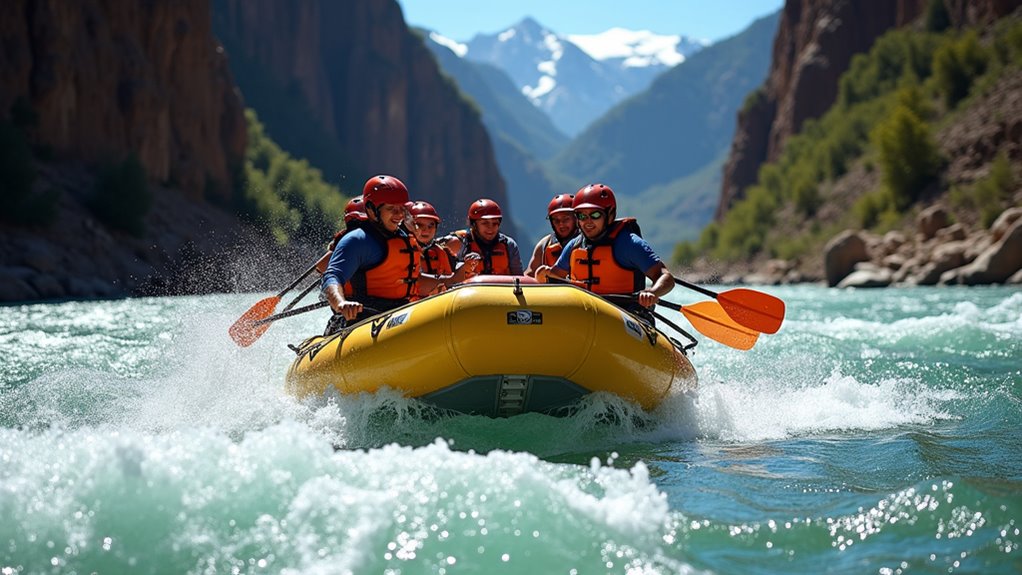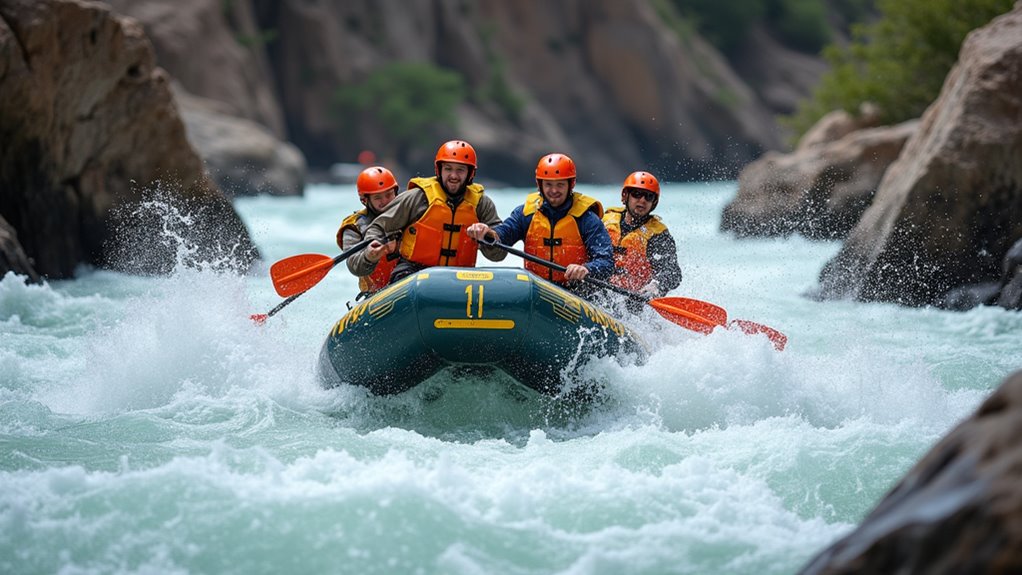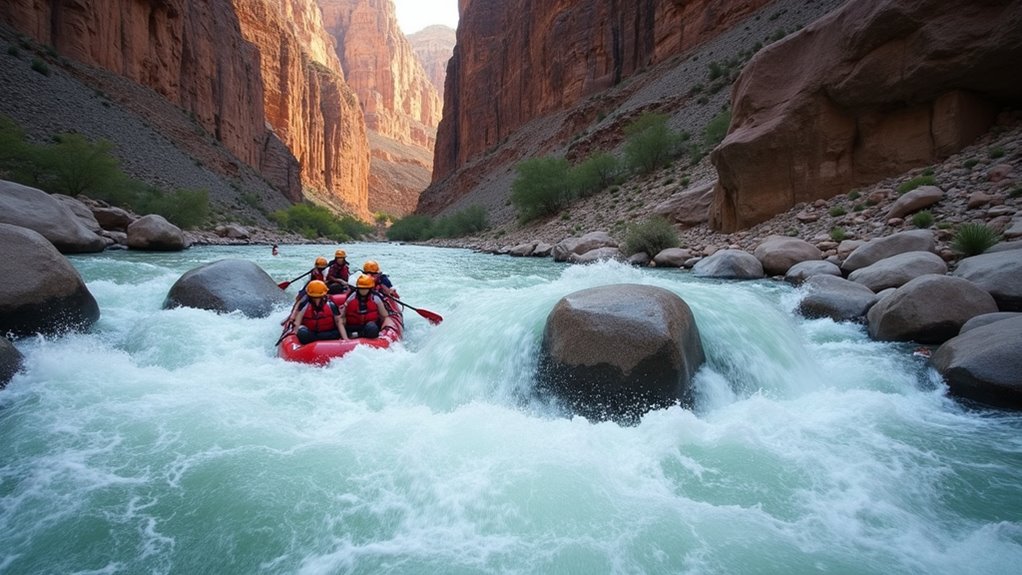Physical Address
304 North Cardinal St.
Dorchester Center, MA 02124
Physical Address
304 North Cardinal St.
Dorchester Center, MA 02124

Knowing these essential Colorado white water safety tips could mean the difference between an epic adventure and a tragic headline.
When the Arkansas River claimed three lives during the 2019 spring runoff season, it served as a stark reminder that Colorado’s white waters don’t forgive poor preparation. You’re probably excited about your upcoming rafting adventure, but there’s a difference between thrilling and dangerous – and that difference often comes down to knowing what you’re doing before you hit the water. The good news? You don’t need expensive gear or years of experience to stay safe, but you do need the right knowledge.

When you’re planning a rafting trip in Colorado, you’ll quickly discover that high-altitude conditions create a completely different river experience than what you’d find at sea level. Colorado’s rivers typically flow between 5,000 and 8,000 feet elevation, where you’ll face colder water temperatures year-round—even summer flows rarely exceed 60°F.
The thinner air means you’ll tire faster and need more frequent breaks, so budget extra time for your trip.
Snowmelt drives most Colorado rivers, creating powerful spring runoffs that peak between May and July. Water levels can change dramatically within hours, transforming gentle Class II rapids into dangerous Class IV torrents.
You’ll want to check real-time flow data before launching and consider hiring local guides who understand these variable conditions. Their expertise often costs less than dealing with emergency rescues. Just as important as planning your river route is selecting the right camping backpack for overnight rafting expeditions, where waterproof storage and proper weight distribution become critical for multi-day adventures.
Colorado’s unpredictable river conditions demand specific safety equipment that’ll keep you protected without breaking your budget. You’ll need a properly fitted personal flotation device (PFD) – don’t skimp here, as Colorado law requires Coast Guard-approved life jackets.
Colorado’s challenging waters require Coast Guard-approved PFDs by law – invest in proper flotation gear to ensure your safety.
A well-fitting helmet protects against rocks and unexpected impacts.
Pack a whistle for emergency signaling and waterproof bags for essentials like medications and car keys.
Quick-dry clothing works better than cotton, which stays wet and cold.
Neoprene booties protect your feet from sharp rocks while providing better grip.
Consider renting expensive items like wetsuits if you’re rafting infrequently.
Always carry a throw rope and basic first aid supplies.
Check that all gear meets safety standards before hitting the water – your life depends on reliable equipment.
Just like anglers who master bass fishing techniques through practice and proper preparation, successful rafting requires developing skills with your safety equipment before you encounter challenging rapids.

Before you book that first rafting trip, you’ll want to match your experience level with Colorado’s river classifications to avoid costly mistakes or dangerous situations. Colorado uses the International Scale of River Difficulty, ranging from Class I (easy) to Class VI (extreme).
If you’re a beginner, stick with Class I-II rivers like the lower Colorado River near Glenwood Springs. These cost less and offer gentle rapids perfect for families.
Intermediate rafters can tackle Class III waters such as sections of the Arkansas River, while experienced adventurers might choose Class IV-V runs.
Don’t let ego drive your decision—misjudging difficulty levels leads to expensive gear replacement, potential injuries, and ruined trips. Research specific river sections, seasonal flow changes, and consult local outfitters who know current conditions best.
Consider combining your rafting adventure with family camping activities to create a memorable multi-day outdoor experience that everyone can enjoy.
Since Colorado’s mountain weather changes rapidly and dramatically affects river conditions, you’ll need to plan your rafting trip around seasonal patterns to avoid wasted money and dangerous situations.
Peak season runs May through September, but don’t book blindly. Early season (May-June) brings snowmelt-fed rapids that’ll challenge even experienced rafters, while late season (August-September) offers calmer, warmer conditions perfect for families.
Check weather forecasts religiously—afternoon thunderstorms can create flash floods within minutes. Morning trips often dodge these storms entirely, saving you from costly cancellations.
Water temperatures stay brutally cold year-round, hovering around 45-55°F even in summer. You’ll need proper gear regardless of air temperature.
Book refundable trips when possible. Colorado’s unpredictable weather makes flexibility your best investment for a successful rafting adventure.
If you’re new to white water adventures, consider whether renting equipment first makes more financial sense than purchasing gear outright before committing to regular rafting trips.

While weather sets the stage for your rafting adventure, water levels determine whether you’ll actually get on the river. Colorado’s snowmelt-fed rivers fluctuate dramatically throughout the season, making flow monitoring essential for both safety and budget planning.
Check the USGS water data website before booking your trip. Flow rates measured in cubic feet per second (CFS) dictate difficulty levels.
Spring runoff creates dangerous high-water conditions, while late summer brings shallow, rocky obstacles that can damage equipment and increase costs.
You’ll save money by timing trips during ideal flow windows—typically mid-June through August for most Colorado rivers.
Low flows mean potential trip cancellations and refund hassles. High flows can bump you into more expensive guided options when self-guided permits aren’t issued for safety reasons. Beyond water hazards, rafters should also prepare for potential encounters with Colorado’s mountain wildlife by learning wildlife safety tips that can prevent dangerous situations during riverside camping.
Once you’ve confirmed ideal water levels, choosing the right guide can make or break your Colorado rafting experience—and your wallet. Don’t just book the cheapest option—research operators thoroughly. Check their safety certifications, insurance coverage, and guide training requirements. Look for companies with certified wilderness first aid instructors and swift water rescue training.
Read recent reviews focusing on safety protocols, not just fun factor. Ask about guide-to-guest ratios—smaller groups mean better attention and safety oversight. Verify they provide proper safety equipment like helmets, life jackets, and throw bags.
Compare what’s included in pricing. Some operators bundle lunch, transportation, and photos while others charge extra. Licensed, established companies might cost more upfront but prevent costly emergencies or disappointing trips. Just like with RV purchases, avoiding common mistakes during the booking process will save you from regret and ensure you get the best value for your adventure investment.

Although Colorado rafting doesn’t require Olympic-level fitness, you’ll need enough strength and endurance to paddle for several hours and handle unexpected swims in cold mountain water.
Start preparing at least a month before your trip with these essential fitness areas:
Give yourself at least four weeks to build the stamina and strength needed for a successful Colorado rafting adventure.
Don’t worry if you’re not a gym regular – basic fitness combined with proper technique will serve you well. Most outfitters accommodate various fitness levels and provide appropriate river sections for your group’s abilities. Like any family camping adventure, proper physical preparation ensures everyone can fully participate and create lasting memories together.
Even with proper preparation and safety gear, emergencies can happen on Colorado’s unpredictable rivers, making it crucial that you understand basic self-rescue techniques before you launch.
If you’re thrown from your raft, assume the defensive swimming position immediately: lie on your back with feet up and pointed downstream to fend off rocks. Keep your arms out for balance and swim toward the nearest shore using backstroke movements.
For boat-to-boat rescues, the T-rescue technique works best—position your raft perpendicular to the flipped craft and help victims climb aboard. Always throw ropes underhand to swimmers, keeping one end secured to your boat.
Practice the Eskimo roll if you’re in a kayak, and memorize hand signals for communication during rescues.
Always inform someone of your rafting itinerary and expected return time before heading out on the water, as this information becomes vital if search and rescue teams need to locate your group.

While emergency skills keep you safe when things go wrong, recognizing river hazards before you encounter them is your first line of defense on Colorado’s challenging waterways.
You’ll save money on gear replacement and potential rescue costs by learning to spot trouble ahead. Start by reading the water upstream—look for telltale signs like horizon lines indicating drops, white foam patterns showing rocks, and dark channels revealing deeper routes.
Master these three essential navigation strategies:
Practice reading water during calmer sections so you’re prepared when the stakes get higher downstream. Just as travelers develop safety awareness when using unfamiliar public transport systems in foreign countries, rafters must cultivate heightened vigilance when navigating new river sections.
Once you’ve pulled your raft off Colorado’s rivers, your safety responsibilities don’t end at the takeout. Start by checking everyone for injuries – adrenaline masks pain, and cuts or bruises often appear later.
Rinse all gear thoroughly with fresh water to remove sediment and prevent mold. Don’t pack wet equipment away; spread it out to dry completely.
Inspect your raft for punctures, worn fabric, or loose seams. Check valves and patch any damage immediately – small tears become expensive repairs.
Clean life jackets and helmets, then store them in a dry, ventilated area. Replace worn throw ropes and damaged paddles before your next trip.
Document any equipment issues in a simple logbook. This cheap habit prevents gear failure when you’re miles from help on remote Colorado rivers.
Consider planning your next family camping adventure to complement your white water rafting experiences and create lasting outdoor memories together.
You’ve heard that expensive gear guarantees safety, but here’s the truth: proper preparation beats pricey equipment every time. Sure, you’ll need quality basics like a solid life jacket and helmet, but your knowledge of river conditions and self-rescue skills matter more than top-shelf accessories. Focus your budget on experienced guides and essential safety gear first. Master the fundamentals, respect Colorado’s unpredictable waters, and you’ll create unforgettable adventures without breaking the bank.